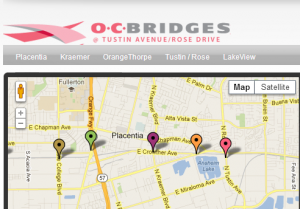Road project bulldozes building owner’s equity
By Dave Roberts
If you live near or frequently travel along the Burlington North Santa Fe rail line in north Orange County, you’re probably looking forward to the completion of the $600 million in road improvements that are under construction in that area. Currently, motorists are stuck at intersections waiting for trains to pass through a plethora of at-grade railroad crossings. Nearby residents and businesses suffer the blast of train horns throughout the day.
When the Orange County Transportation Authority’s OC Bridges program is completed in 2015, seven at-grade crossings will be replaced by a series of bridges separating cars from trains. Without these improvements, by 2030 a train would be blocking an intersection every 10 minutes, according to the OCTA.
But, while the project is a godsend to many, it is threatening to rob the savings of Kathy Hoke, a widow who owns an office building stuck in the middle of the construction. As a result of the noise, disruption and concerns about limited access to the building, half of her tenants have fled the building with more likely to follow. The building has lost more than half its value. Upside down on the mortgage and unable to keep up the payments, Hoke is now facing foreclosure and potentially owes another $1 million to the bank.
“Needless to say, this has turned my life upside down at the age of 54, and I may now face bankruptcy,” said Hoke. “I am a widow about to lose everything that my late husband and I have worked for. This has consumed my life for almost three years. I go to sleep thinking about it, and it is the first thing on my mind when I awake. This has turned my life upside down, while OCTA sits back and takes absolutely no responsibility for what has occurred with the building and this Bridge Project. I am all alone fighting this, and it simply isn’t fair what they have done to me.”
The 17,000 square-foot HFT Professional Building at 1150 East Orangethorpe Avenue in Placentia started out as a good investment, promising to provide steady income for Kathy and her husband, Edward’s, retirement. It’s an attractive building in a good location with underground parking and nearby shopping centers. It was nearly fully occupied with tenants, some of whom had been there for 10 or more years. It’s also not far from the Hokes’ home in Yorba Linda. So it seemed well worth the $2.8 million that they paid in December 2007 with a $1 million down payment from the proceeds of the sale of Edward’s business.
“We did not know about the OCTA Bridge project at the time of this purchase,” said Kathy. “And if we had known, we never would have purchased the building.”
For the next 21 months, things were fine. But things began to unravel on September 28, 2009 when Kathy woke to find that her husband had died of a heart attack in his sleep. A reappraisal of the building as part of the estate settlement revealed that it had already lost $400,000 of its value due to the real estate and economic slowdown.
OCTA nightmare
Kathy’s OCTA nightmare began not long after that in the spring of 2010 when she found out that the building, which is on the south side of Orangethorpe Avenue, would be sandwiched between two major construction projects.
Orangethorpe Avenue is being reconstructed as a bridge over the railroad tracks, descending back to street level just west of Hoke’s building. The project will be constructed in phases, allowing Orangethorpe to remain open during construction. But its six lanes will be reduced to one lane in each direction. Construction is scheduled to be completed in mid-2015.
On the other side of the building to the east, a bridge will be constructed over the tracks at Orangethorpe Avenue where it intersects with Tustin Avenue and Rose Drive. Orangethorpe will be widened and restriped to accommodate turn lanes. The intersection will be closed for a substantial portion of the construction, which is scheduled to be completed by 2015.
In essence, for the next two years Hoke’s building is going to be in the path of a blitzkrieg of construction. And her tenants have been fleeing like refugees.
One business that had been in the building for 15 years sent a letter citing the “inconvenience with regards to traffic, loudness, pollution and other things that come along with construction” as reasons for leaving.
“I, for one, would not recommend any prospective tenant to move in this building given the construction that will be taking place!” added Naren Mistry, manager for BeyondTek IT.
The building’s anchor tenant, Fullerton Insurance, which occupied 5,700 square feet, wrote in its “Dear John” letter, “[W]e are a sales organization and with 15 sales people who have to have access in and out of our office throughout the day. We could not afford the loss of time trying to go around the closure for the year to year and a half that is planned.”
Many other tenants have fled as well. Those that have stayed have declined to renew their leases, preferring to keep their options open with a month-to-month arrangement. In July 2010, Hoke was collecting nearly $27,000 in monthly rent from the building tenants. A year later, in July 2011, that had been reduced to just over $12,000. For a year and a half she dug into her savings to keep up the mortgage payments.
“After paying $175,000 from my personal funds, I realized that I could not continue to subsidize the building due to the length of this three-year project,” she said.
Plummeting property value
She stopped making loan payments in April 2012, resulting in Wells Fargo placing the building in receivership to manage the building and requiring another appraisal. This time the building’s value had plummeted dramatically to just $1.4 million. Another appraisal last October revealed a continued bleeding of value, dropping it to $1.3 million, less than what Hoke owes on it.
The shopping centers near her building have been purchased by OCTA, with one razed to make way for construction and the other used by the contractor for construction staging. But, while OCTA initially indicated interest in also purchasing Hoke’s building, it decided not to make an offer.
In August 2011, Hoke’s attorney Mike D’Angelo wrote a letter to the law firm representing OCTA, requesting that the agency also purchase Hoke’s building.
“Ms. Hoke’s property is the only one within the entire O.C. Bridges Project that is situated as it is, directly between two bridge constructions, and not slated for acquisition,” D’Angelo wrote. “OCTA’s acquisition activities have left the property as an island surrounded by project construction. To date, OCTA has responded to Ms. Hoke’s concerns simply by noting that, because it will not be acquiring any portion of the subject property, none of the project-related damages to her property are compensable.
“But that is not the law. The California Supreme Court has long held that a landowner is entitled to just compensation for a substantial impairment of access to her property. No reasonable dispute can exist but that access to the subject property has been impaired as a result of the project. Based upon the substantial and ongoing impairment of access to the subject property and damages resulting there from, we are requesting OCTA to acquire the subject property immediately and for fair market value.”
Craig Farrington, representing OCTA, responded last April, denying the request.“As you are aware, no part of the project is designed to directly touch Ms. Hoke’s property,” he wrote in his letter. “At this time, we are not aware of any legal theory which would justify payment of public funds to Ms. Hoke for any loss of tenants.”
This week Joel Zlotnik, OCTA media relations officer, confirmed that OCTA’s position has not changed.
“Regarding Ms. Hoke, OCTA has been in contact with her and we understand her concerns,” he said. “Throughout the design and construction process, OCTA works closely with the community to minimize the impacts of construction. Ms. Hoke’s property was not identified as being needed for the project, and per state and federal law, OCTA can only acquire properties that are necessary to construct the project. The construction and outreach team will continue to work with the businesses in the area during construction on access and signage, so the public is aware that businesses are open during construction.”
Law works against property owners
D’Angelo acknowledged in an interview that Farrington is correct that the law does not permit compensation to a building or business owner for lost income or value due to the nuisances and inconveniences of a nearby public construction project.
“The case law in recent years has been very restrictive against property owners in situations like that,” said D’Angelo. “Usually they are more helpful when the property is going to be taken. The problem for Ms. Hoke is that it wasn’t designated for action. That’s not to say we might not have courses of action accruing once construction commences and access to the property is significantly impaired, as we anticipate it is going to be. If the property is physically damaged or impaired, then we can revisit the issue to see whether we can seek damages. In the meantime, what I was trying to accomplish is basically appeal to their sense of fairness and step up and help this woman who’s unequally impacted by this project to her tremendous detriment.”
The only winner in this situation may turn out to be Wells Fargo. The bank might foreclose on the building, getting it at a significant discount under its current appraised value; then collect nearly another million dollars from Hoke in unpaid mortgage, loan interest, penalties and legal fees; then sell the building in a couple years at its restored market value when the road construction is completed.
“This is truly a unique circumstance,” said D’Angelo. “I have never seen anything like it in 16-plus years in practicing in this area. She’s being double penalized. Not only is the property not turning over enough money, but it’s being foreclosed. And the very same conditions causing lost rent and inability to pay the mortgage and default are being used to depress the value of the property and increase the [loan] deficiency she’s responsible for. So she’s really getting screwed at both ends here — it’s awful.”
Hoke said, “I don’t feel like I have anyone to turn to. The bank is not cutting me any slack. If they foreclose on me, then they can go after my personal assets, my home and everything else. It’s a stressful situation. Everybody is sympathetic, everybody feels sorry for you. But that’s as far as anything goes.”
Hoke’s initial court date in the Wells Fargo lawsuit against her is May 17.
Related Articles
San Diego Wheels, Deals and Sues for Water
Commentary May 7, 2012 By Wayne Lusvardi San Diego’s recent transfer of excess agricultural water from Imperial County has been the only
State Board Loans State Dept Money
Dec. 17, 2010 By KATY GRIMES On Dec. 15, a state investment fund loaned more than a million dollars to
How do you like your higher electricity bill?
On CalWatchDog.com, for four years Wayne Lusvardi has been detailing in hundreds of articles the effective dismantling of California’s and




